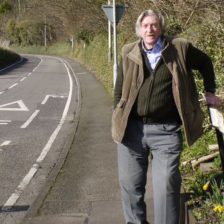The following letter provides details from Perth & Kinross Traffic & Network Department.
Bruce
Apologies for not getting back to you sooner but other priorities of work had overtaken this project. I have now had an opportunity to assess the concerns contained in your letter dated 24th April 2014.
Speed Limit
Over the past few months, we have been assessing a number of requests for a lower speed limit around Kinross-shire, including the section of the A911 east of Scotlandwell. As you are aware, the Speed Limit Review of all A and B Class Roads across the Council area was undertaken in 2009/10 in consultation with (then) Tayside Police, Local Elected Members and Community Councils. Key information gathered during the Review included traffic volumes, mean speeds, accident history, road layout and road environment. A report was submitted to, and approved by, the Enterprise & Infrastructure Committee in May 2010. This included a recommendation that a 40mph speed limit should be introduced at Auchmuirbridge and between Wester Balgeddie and Easter Balgeddie. At the time of the Review, there was a request from one of the Local Elected Members for a lower speed limit on the A911 between Scotlandwell and Auchmuirbridge. The existing national speed limit was considered appropriate for this rural sections of road.
Subsequent traffic surveys were undertaken in the vicinity of Arnot in 2012 and 2013 at the request of one of the Ward Councillors and a local resident. The survey data showed little change in vehicle speeds on this part of the A911, and the road alignment remained unchanged. Following consultation with the Police, Perth & Kinross Council did not consider lowering the speed limit on the A911 between Scotlandwell and Auchmuirbridge to be appropriate. This position was last conveyed to the Community Council in January 2014.
Following your letter in April, the route has been assessed again. The road is still largely rural in environment. The additional housing development along the road does not appear to have had any significant impact on the traffic patterns or vehicle speeds. As the site does still not satisfy the criteria for a lower speed limit, the Council does not recommend changing the national speed limit of the road between Scotlandwell and West Bowhouse.
Visibility Splays
The apparent failure to provide the required visibility splay to the west of West Bowhouse is a matter for the Development Management Team within Planning & Regeneration. This issue will be passed to the Planning Enforcement Officers for investigation.
Bus Boarding Facility
The absence of bus boarding facilities on both sides of the road will be passed to the Planning Enforcement Officers for investigation.
Warning signs and road markings
Warning signs to inform drivers of the possibility of pedestrians in the road ahead can be erected on both approaches to West Bowhouse. The existing double bend warning signs and road markings will be reviewed. If considered necessary, the signs can be relocated or upgraded to improve their conspicuity and provide drivers with greater notice of the potential hazards ahead. The centreline marking will be assessed in for a double line system in partnership with the Police as contravention of the prohibitory line is an endorsable traffic offence. The Community Council will be advised of the outcome of these assessments in due course.
I trust this clarifies the position regarding your areas of concern. If you require any further information do not hesitate to contact me,
Daryl
Daryl McKeown
Road Safety Officer
Traffic and Network
The Atrium
137 Glover Street
Perth PH2 0HY
T. 01738 477387
